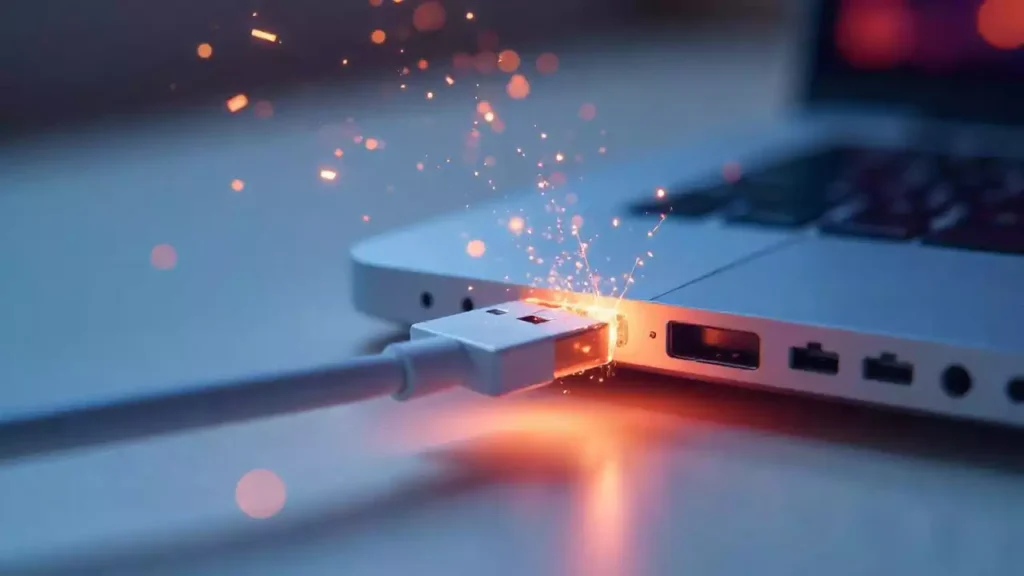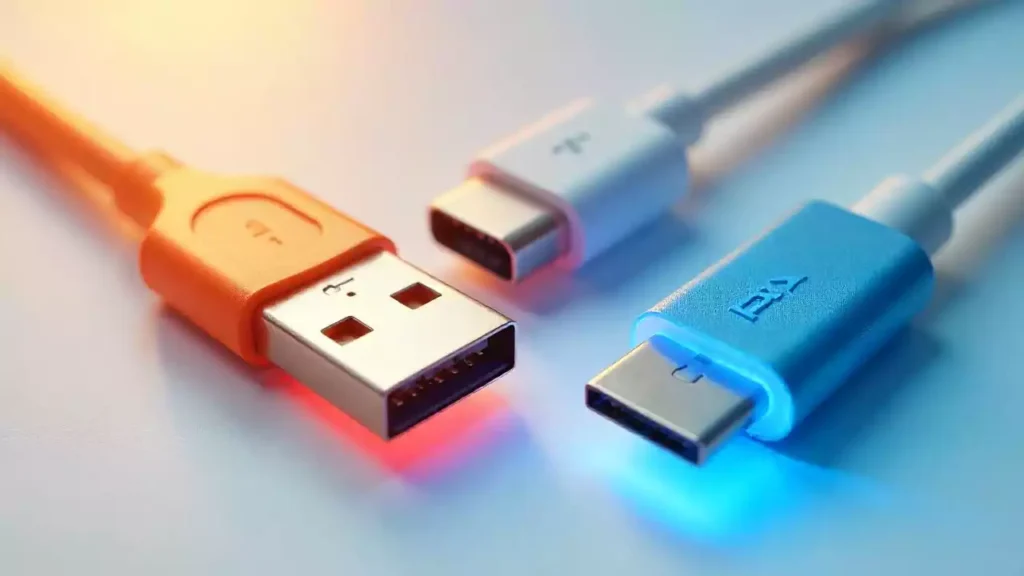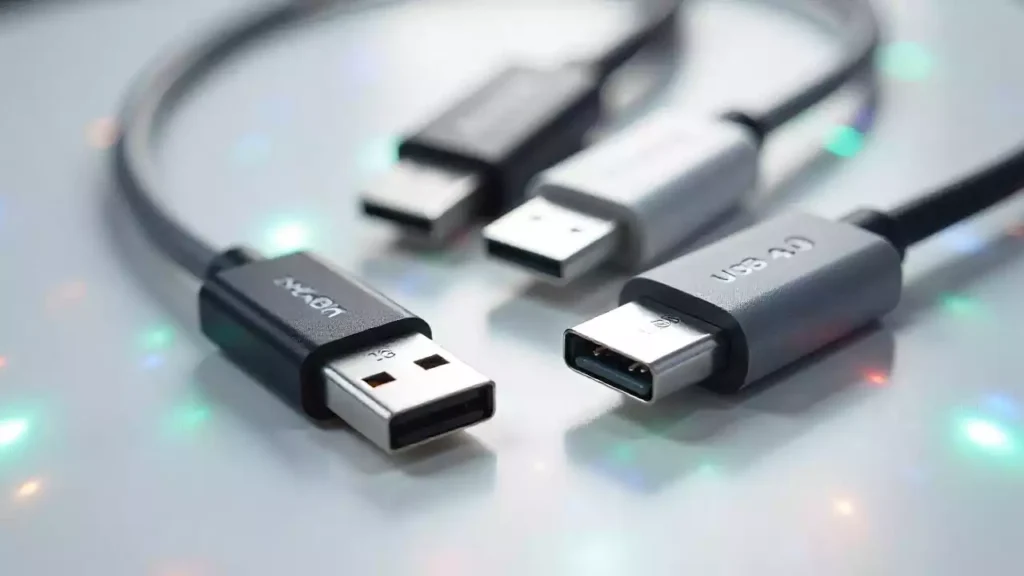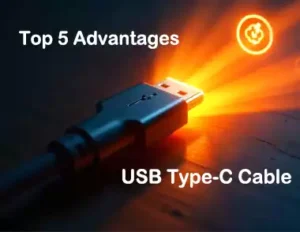
Table of Contents
USB 4.0 cable represents a leap forward in connectivity, offering unmatched speed and versatility. With data transfer rates reaching up to 40 Gbps, it doubles the speed of USB 3.2 and is eight times faster than USB 3.0 cables. You can upload and download files simultaneously, saving time and boosting productivity. Its backward compatibility ensures seamless connections with older USB and Thunderbolt 3 devices.
The USB 4 cable simplifies your tech setup by combining data, video, and power delivery into one solution. It supports multiple protocols, enabling connections to external graphics cards, monitors, and more. The table below highlights key advancements:
Feature | USB 4.0 Benefits |
Speed | Transfers data at 40 Gbps, twice as fast as USB 3.2. |
Two-way Data Transfer | Allows simultaneous uploads and downloads. |
Backward Compatibility | Works with USB 2.0, USB 3.x, and Thunderbolt 3 devices. |
Power Delivery | Delivers up to 100 watts, ideal for high-power devices. |
Multi-Display Support | Connects multiple 4K or 8K monitors for enhanced productivity. |
Connector | Exclusively uses USB-C, offering a reversible and universal design. |
This technology transforms how you interact with devices, whether you’re transferring files, gaming, or managing multiple displays. USB 4.0 ensures faster, smarter, and more efficient performance for modern needs.
Key Takeaways
- USB 4.0 can transfer data at speeds up to 40 Gbps. This is twice as fast as USB 3.2, making file transfers quicker for work and gaming.
- The USB 4 cable lets you upload and download at the same time. This helps you do more tasks without slowing down.
- USB 4.0 works with older USB versions, so you can use it with your current devices without buying new ones.
- The USB-C connector works with many devices. It makes charging, moving files, and connecting screens simple with one cable.
- Buying certified USB 4 cables gives you the best speed and power. It also works well with future devices.
What is USB 4.0?

Overview of USB 4.0 technology
USB 4.0 represents the latest evolution in universal connectivity. It builds on the foundation of previous USB versions while introducing groundbreaking features. This technology offers a maximum data transfer speed of 40 Gbps, which is twice as fast as USB 3.2. It also supports bidirectional data flow, allowing you to send and receive data simultaneously. USB 4.0 uses the USB-C connector, a universal and reversible design that simplifies connections across devices.
Unlike earlier versions, USB 4.0 integrates multiple protocols, such as PCIe (Peripheral Component Interconnect Express) and DisplayPort. This means you can connect a variety of devices, from external GPUs to high-resolution monitors, with a single cable. Additionally, it includes smart bandwidth allocation, ensuring optimal performance for all connected devices.
Specification | USB 4.0 | Earlier Versions |
Maximum Data Transfer Speed | 40 Gbps | Up to 20 Gbps (USB 3.2) |
Bidirectional Data Flow | Yes | No |
Backward Compatibility | USB 2.0, USB 3.x, TB3 | Limited |
Support for Multiple Protocols | Yes (PCIe, DP) | Limited |
Smart Bandwidth Allocation | Yes | No |
Connector Type | USB-C | Various |
Key advancements in USB 4.0
USB 4.0 introduces several advancements that set it apart from its predecessors. It delivers a seamless experience by combining data transfer, video output, and power delivery into one solution. With support for up to 100 watts of power, it can charge high-power devices like laptops and monitors efficiently. The integration of Thunderbolt 3 technology enhances its performance, making it faster and more versatile.
This version also prioritizes compatibility. It works with older USB standards and Thunderbolt 3 devices, ensuring you don’t need to replace all your existing peripherals. Its ability to support multiple 4K or even 8K displays makes it ideal for professionals and gamers alike.
Why USB 4.0 is essential for modern devices
Modern devices demand faster speeds, higher power, and greater versatility. USB 4.0 meets these needs by offering a unified solution for data, video, and power. Whether you’re transferring large files, connecting multiple displays, or charging your devices, USB 4.0 ensures optimal performance. Its backward compatibility also makes it a practical choice for upgrading your tech setup without discarding older devices.
For users who rely on high-speed data transfer or multi-display setups, USB 4.0 is a game-changer. It simplifies your workspace by reducing the number of cables needed, while its universal USB-C connector ensures ease of use. With a USB 4 cable, you can future-proof your devices and enjoy cutting-edge performance.
Key Features of USB 4 Cable

Here are 5 key features of USB 4 cable,
The USB 4 cable offers blazing-fast data transfer speeds of up to 40 Gbps. This speed is twice as fast as USB 3.2 and significantly faster than older USB standards. With this capability, you can transfer large files, such as 4K videos or high-resolution images, in seconds. Whether you’re a professional working with massive datasets or a gamer downloading large updates, this feature saves you time and enhances productivity.
The high-speed performance also supports simultaneous data transfer and video output. For example, you can connect an external monitor while transferring files without experiencing any lag. This makes the USB 4 cable an excellent choice for multitasking and high-performance setups.
Advanced power delivery for faster charging
USB 4 cables redefine power delivery by supporting up to 240 watts of power. This is a significant improvement over USB 3.0, which only delivers up to 4.5 watts. The table below highlights the difference:
| USB Standard | Power Delivery Capability |
| USB 3.0 | Up to 900 mA at 5 V |
| USB 4.0 | Up to 240 W (5A at 48V) |
With this advanced power delivery, you can charge high-power devices like laptops, monitors, and even some gaming systems faster than ever. This feature is especially useful for professionals who rely on quick charging to stay productive. You no longer need multiple chargers for different devices, as the USB 4 cable handles it all efficiently.
Compatibility with Thunderbolt 3 and 4
USB 4 cables are designed with compatibility in mind. They work seamlessly with Thunderbolt 3 and 4 devices, ensuring you can use your existing peripherals without any issues. Here are some key compatibility features:
- Thunderbolt 4 and USB 4 cables are interchangeable.
- USB 4 cables are backward compatible with all previous generations of USB-C.
- High-quality Thunderbolt 3 cables work with USB 4, providing optimal performance.
USB 4 technology is derived from Thunderbolt 3, which means most Thunderbolt 3 devices will work with USB 4 devices. The type of cable you use, whether USB 4 or Thunderbolt 3 compliant, does not affect compatibility. This ensures a smooth transition to USB 4 without the need to replace your current setup.
Support for 4K/8K video and multi-display setups
USB 4.0 takes video output to the next level by supporting 4K and 8K resolutions, along with multi-display setups. This capability makes it ideal for professionals and enthusiasts who need high-quality visuals or additional screen space. Whether you’re editing videos, designing graphics, or gaming, USB 4.0 ensures a seamless and immersive experience.
The technology behind this feature is impressive. USB 4.0 is compatible with DisplayPort 2.0, which allows you to connect multiple 4K monitors or a single 8K display using just one cable. This eliminates the need for multiple connections and simplifies your workspace. Thunderbolt 3, which USB 4.0 integrates, requires at least DisplayPort 1.2 for 4K at 60 Hz output. However, USB 4.0’s higher bandwidth enables even better performance, making it a game-changer for video output.
Here’s a quick comparison of USB 4.0’s video capabilities:
Feature | USB 4.0 | USB 3.2 |
Maximum Resolution | 8K | 4K |
Multi-Display Support | Yes (up to 2-3 displays) | Limited |
DisplayPort Compatibility | DisplayPort 2.0 | DisplayPort 1.4 |
This feature is particularly beneficial for creative professionals. For instance, video editors can preview their work on multiple screens, while graphic designers can use the extra space for tools and palettes. Gamers also benefit from smoother visuals and higher resolutions, enhancing their overall experience.
Tip: To fully utilize USB 4.0’s video capabilities, ensure your devices and cables support DisplayPort 2.0. This ensures optimal performance for 4K/8K displays.
Simplified and universal USB Type-C connector
The USB 4 cable exclusively uses the USB Type-C connector, which simplifies connectivity across devices. Unlike older USB connectors, USB-C is reversible, so you no longer need to worry about plugging it in the wrong way. This small but significant improvement saves time and reduces frustration.
USB-C’s universal design makes it compatible with a wide range of devices, from laptops and smartphones to monitors and external drives. This means you can use a single cable for multiple purposes, such as charging, data transfer, and video output. The USB 4 cable enhances this convenience by combining all these functions into one solution.
Here are some key benefits of the USB Type-C connector:
- Reversible Design: Plug it in any direction without hassle.
- Universal Compatibility: Works with most modern devices, reducing the need for multiple cables.
- Compact Size: Smaller than previous connectors, making it ideal for slim devices.
The USB-C connector also supports advanced features like power delivery and high-speed data transfer. For example, you can charge your laptop while transferring files or streaming video to an external monitor. This versatility makes USB 4 cables an essential tool for modern tech setups.
Note: While USB-C is universal, not all USB-C cables support USB 4.0 features. Look for certified USB 4 cables to ensure compatibility and performance.

USB Type-C vs. USB Type-A
When choosing a USB 4 cable, understanding the difference between USB Type-C and USB Type-A is essential. USB Type-C is the standard connector for USB 4.0. It features a compact, reversible design, making it easier to plug in without worrying about orientation. Type-C supports faster data transfer, higher power delivery, and compatibility with advanced features like 4K/8K video output.
On the other hand, USB Type-A is the older, rectangular connector found on many legacy devices. While USB 4.0 primarily uses Type-C, some adapters or cables may include Type-A connectors for backward compatibility. However, these cables may not support the full capabilities of USB 4.0, such as 40 Gbps speeds or advanced power delivery.
Feature | USB Type-C | USB Type-A |
Design | Reversible, compact | Non-reversible, larger |
Speed Support | Up to 40 Gbps | Limited to older standards |
Power Delivery | Up to 240 W | Lower power capabilities |
Compatibility | Modern devices | Legacy devices |
Tip: Always choose USB Type-C for full USB 4.0 functionality.
Active vs. Passive Cables
USB 4 cables come in two types: active and passive. Active cables contain built-in electronics to boost signal strength over longer distances. These cables maintain high performance, even when extended beyond standard lengths. They are ideal for setups requiring longer connections, such as multi-display configurations or external storage devices.
Passive cables, in contrast, lack signal-boosting components. They are shorter and more affordable but may not deliver the same performance over long distances. For example, passive cables typically support 40 Gbps speeds only up to 0.8 meters. Beyond this length, their performance may drop.
Cable Type | Features | Best Use Case |
Active | Signal boosting, longer range | Multi-display setups |
Passive | Affordable, shorter range | Everyday use, short distances |
Note: If you need a cable longer than 1 meter, consider an active USB 4 cable to avoid performance loss.
Choosing the Right USB 4.0 Cable
Selecting the right USB 4 cable depends on your needs. First, check your device’s compatibility. Most modern devices use USB Type-C, so prioritize cables with this connector. Next, consider the cable length. For short connections, a passive cable works well. For longer distances, choose an active cable to maintain speed and reliability.
Look for certified USB 4 cables to ensure quality and performance. Certified cables meet industry standards and support all USB 4.0 features, including 40 Gbps speeds, 240 W power delivery, and 4K/8K video output. Avoid uncertified cables, as they may not deliver the expected performance.
Pro Tip: Check the packaging or product description for “USB 4.0 Certified” to guarantee compatibility and performance.
USB 4 Cable vs. Previous USB Versions
USB 4.0 vs. USB 3.2: Speed and functionality
When comparing USB 4.0 to USB 3.2, the differences in speed and functionality are significant. USB 4.0 offers a maximum data transfer speed of 40 Gbps, which is twice as fast as USB 3.2’s 20 Gbps. This means you can transfer large files, such as 4K videos, in half the time. USB 4.0 also supports two-way data transfer, allowing you to send and receive data simultaneously, which improves efficiency.
Another key improvement is dynamic bandwidth allocation. USB 4.0 adjusts bandwidth based on the connected devices, ensuring optimal performance. In contrast, USB 3.2 uses fixed bandwidth, which can limit its efficiency in multi-device setups. Additionally, USB 4.0 supports up to two 4K monitors or one 8K monitor, while USB 3.2 only supports a single 4K display.
Feature | USB 3.2 | USB 4.0 |
Max Speed | 20 Gbps | 40 Gbps |
Port Type | USB-A, USB-B, USB-C | USB-C |
Display Support | 1 x 4K monitor | 2 x 4K monitors or 1 x 8K monitor |
Compatibility | Limited Thunderbolt 3 | Supports Thunderbolt 3 |
Bandwidth Allocation | Fixed | Dynamic |
Tip: If you need faster speeds and better display support, upgrading to USB 4.0 is a smart choice.
USB 4.0 vs. USB 2.0: Bridging the gap
USB 4.0 bridges the massive gap between modern and legacy USB standards. USB 2.0, introduced in 2000, offers a maximum speed of just 480 Mbps. In comparison, USB 4.0 is 80 times faster, with speeds up to 40 Gbps. This makes USB 4.0 ideal for transferring large files, streaming high-resolution video, and powering demanding devices.
USB 4.0 also supports advanced features like power delivery and multi-display setups, which USB 2.0 lacks entirely. While USB 2.0 uses older connectors like USB-A and USB-B, USB 4.0 exclusively uses the USB-C connector, which is reversible and more versatile. Despite these differences, USB 4.0 remains backward compatible with USB 2.0, allowing you to connect older devices.
Feature | USB 2.0 | USB 4.0 |
Max Speed | 480 Mbps | 40 Gbps |
Connector Type | USB-A, USB-B | USB-C |
Power Delivery | No | Up to 240 W |
Display Support | No | 4K/8K support |
Backward Compatibility | USB 1.x | USB 3.x, 2.0, Thunderbolt 3,4 |
Note: While USB 4.0 works with USB 2.0 devices, you won’t experience the full benefits unless both devices support USB 4.0.
USB 4.0 vs. Thunderbolt 3 and 4: Key differences
USB 4.0 shares many features with Thunderbolt 3 and 4, as it incorporates Thunderbolt technology. All three offer data transfer speeds of up to 40 Gbps and support power delivery up to 100 watts. However, USB 4.0 stands out for its broader compatibility. It works with both USB and Thunderbolt devices, making it a more versatile option.
Thunderbolt 4 improves on Thunderbolt 3 by requiring support for dual 4K displays and stricter performance standards. USB 4.0 matches these capabilities but at a potentially lower cost, depending on the cable and device. If you already use Thunderbolt 3 or 4, USB 4.0 provides a seamless upgrade path.
Feature | Thunderbolt 3 | Thunderbolt 4 | USB 4.0 |
Data Transfer Speed | Up to 40 Gbps | Up to 40 Gbps | Up to 40 Gbps |
Power Delivery | Up to 100W | Up to 100W | Up to 100W |
Multiple Display Support | Yes | Yes | Yes |
Compatibility | Limited USB | Limited USB | Broad USB and Thunderbolt |
Pro Tip: If you need a cable that works with both USB and Thunderbolt devices, a USB 4 cable is your best bet.
Practical Benefits of USB 4 Cable
Faster file transfers for professionals and creatives
USB 4 cables revolutionize file transfers for professionals and creatives. With speeds of up to 40 Gbps, you can transfer large files in seconds. For example, moving a 4K movie or a high-resolution photo album becomes a quick task. This speed significantly boosts productivity, especially for those handling extensive data or high-resolution content.
Content creators and video editors benefit the most. Faster file transfers mean smoother workflows and less time waiting for files to load. Whether you’re editing videos or managing large datasets, USB 4 cables ensure your operations run efficiently.
Tip: To maximize speed, ensure both your device and cable support USB 4.0 features.
Enhanced multi-display setups for work and gaming
USB 4 cables simplify multi-display setups, making them ideal for work and gaming. They support up to two 4K monitors or a single 8K display, providing crisp visuals and extra screen space. This feature is perfect for professionals who need multiple screens for multitasking or gamers seeking an immersive experience.
For instance, you can connect one monitor for editing and another for previewing your work. Gamers can enjoy smoother gameplay with higher resolutions and reduced screen tearing. The ability to handle multiple displays with a single cable reduces clutter and enhances your workspace.
Feature | USB 4 Cable | Older USB Versions |
Maximum Resolution | 8K | 4K |
Multi-Display Support | Yes (up to 2-3 displays) | Limited |
Improved gaming performance and reduced latency
Gamers will notice a significant improvement in performance with USB 4 cables. The high-speed data transfer reduces latency, ensuring smoother gameplay. This is especially important for competitive gaming, where every millisecond counts.
USB 4 cables also support external GPUs, which enhance your gaming setup. By connecting an external graphics card, you can achieve better frame rates and higher-quality visuals. Whether you’re playing fast-paced shooters or exploring open-world games, USB 4 cables deliver a seamless experience.
Note: Pair your USB 4 cable with a compatible device to unlock its full gaming potential.
Universal compatibility for charging and data transfer
USB 4 cables offer universal compatibility, making them a versatile choice for both charging and data transfer. You can use a single cable to connect a wide range of devices, from laptops and smartphones to gaming consoles and external drives. This eliminates the need for multiple cables, simplifying your workspace and reducing clutter.
The USB 4 cable uses the USB-C connector, which is now the standard for most modern devices. Its reversible design ensures you never have to worry about plugging it in the wrong way. This connector supports advanced features like high-speed data transfer, power delivery, and video output, making it an all-in-one solution for your connectivity needs.
One of the standout features of USB 4 cables is their ability to deliver up to 240 watts of power. This means you can charge high-power devices like laptops and monitors quickly and efficiently. At the same time, the cable supports data transfer speeds of up to 40 Gbps, allowing you to move large files in seconds. Whether you’re charging your phone or transferring files to an external drive, the USB 4 cable ensures optimal performance.
Feature | USB 4 Cable | Older USB Standards |
Connector Type | USB-C | USB-A, USB-B |
Power Delivery | Up to 240 W | Limited |
Data Transfer Speed | Up to 40 Gbps | Slower |
Compatibility | Broad (USB and Thunderbolt) | Limited |
Tip: Always check if your devices support USB 4.0 to fully utilize the cable’s capabilities.
The backward compatibility of USB 4 cables ensures they work seamlessly with older USB devices. For example, you can connect a USB 4 cable to a USB 3.0 port and still enjoy reliable performance, though at reduced speeds. This feature makes upgrading to USB 4 cables a practical choice, as you won’t need to replace all your existing devices.
USB 4.0 Cable Use Cases

There are 3 applications for USB 4 cable,
For Gamers
USB 4 cables elevate your gaming experience by delivering faster data transfer and reduced latency. These cables support external GPUs, allowing you to enhance your system’s graphics performance. With an external GPU, you can achieve smoother frame rates and higher-quality visuals, even on laptops or devices with limited built-in graphics power.
The ability to connect multiple high-resolution displays is another game-changer. You can set up dual 4K monitors or a single 8K display for an immersive gaming environment. This feature is especially useful for simulation games or competitive gaming, where every detail matters. The high-speed data transfer ensures that your peripherals, such as gaming keyboards and mice, respond instantly, giving you a competitive edge.
Tip: Pair your USB 4 cable with a compatible device to unlock its full gaming potential.
For Content Creators
USB 4 cables streamline your workflow, making them an essential tool for content creators. The 40 Gbps data transfer speed drastically reduces the time needed to move large files. Whether you’re working with 4K videos or high-resolution images, you can transfer your projects in seconds, saving valuable time.
The integration with Thunderbolt technology allows you to connect multiple peripherals and displays through a single port. This simplifies your setup and reduces cable clutter. For example, you can connect an external hard drive, a 4K monitor, and a camera simultaneously. This versatility enhances your productivity and keeps your workspace organized.
- Key Benefits for Content Creators:
- Faster file transfers for high-resolution media.
- Support for multiple peripherals and displays.
- Simplified and clutter-free setups.
Note: To fully utilize these features, ensure your devices support USB 4.0 and Thunderbolt technology.
For Businesses and Professionals
USB 4 cables offer practical benefits for businesses and professionals who rely on efficient and versatile technology. The ability to connect multiple displays improves productivity in office environments. You can use one screen for presentations and another for data analysis, making multitasking seamless.
The advanced power delivery feature supports fast charging for laptops and other devices. This ensures that you stay powered throughout your workday without needing multiple chargers. Additionally, the backward compatibility of USB 4 cables allows you to connect older devices, making it easier to upgrade your tech setup without replacing everything.
Feature | Benefit for Professionals |
Multi-Display Support | Enhanced multitasking |
Fast Charging | Keeps devices powered all day |
Backward Compatibility | Works with older devices |
Pro Tip: Invest in certified USB 4 cables to ensure reliability and performance in professional environments.
Compatibility and Upgrading to USB 4 Cable
Do you need new cables for USB 4.0?
You might wonder if upgrading to USB 4.0 means replacing all your existing cables. The answer depends on your current setup. USB 4.0 exclusively uses the USB-C connector, so older cables with USB-A or USB-B connectors won’t support its full features. If your devices already use USB-C cables, they may work with USB 4.0, but only if they meet the required specifications for speed and power delivery.
Certified USB 4 cables are designed to handle the full 40 Gbps data transfer speed and up to 240 watts of power. Using uncertified or older USB-C cables could limit performance. For example, a non-USB 4 cable might not support 8K video output or fast charging. To fully enjoy the benefits of USB 4.0, investing in certified cables is a smart choice.
Tip: Look for the “USB 4.0 Certified” label when purchasing new cables to ensure compatibility and performance.
Will USB 4.0 work with older devices?
USB 4.0 is backward compatible with older USB standards, including USB 3.2, USB 3.0, and even USB 2.0. This means you can connect a USB 4 cable to older devices, but the performance will match the older device’s capabilities. For instance, if you connect a USB 4 cable to a USB 3.0 port, the data transfer speed will be limited to 5 Gbps, which is the maximum speed of USB 3.0.
This backward compatibility ensures that you don’t need to replace all your devices immediately. However, to unlock the full potential of USB 4.0, both the cable and the connected devices must support USB 4.0 features.
USB Standard | Maximum Speed with USB 4 Cable | Power Delivery Support |
USB 2.0 | 480 Mbps | Limited |
USB 3.0 | 5 Gbps | Limited |
USB 3.2 | 20 Gbps | Moderate |
USB 4.0 | 40 Gbps | Up to 240 W |
Identifying USB 4.0-compatible devices and cables
Identifying USB 4.0-compatible devices and cables is straightforward if you know what to look for. Most USB 4.0 devices and cables will have a clear label or logo indicating their compatibility. Check the product specifications for terms like “USB 4.0 Certified” or “40 Gbps speed.” For cables, ensure they support advanced features like 8K video output and high power delivery.
You can also verify compatibility by checking the device’s ports. USB 4.0 exclusively uses USB-C ports, so devices with USB-A or USB-B ports won’t support USB 4.0 features. Additionally, Thunderbolt 4 devices are fully compatible with USB 4.0, as they share the same underlying technology.
Pro Tip: Use certified USB 4 cables to avoid performance issues and ensure compatibility with your devices.
Future-proofing your tech setup with USB 4.0
Future-proofing your tech setup means preparing your devices and accessories to stay relevant as technology evolves. USB 4.0 offers a powerful way to achieve this. Its advanced features ensure your devices remain compatible with future innovations while delivering top-notch performance today.
Why USB 4.0 is a Future-Proof Choice
USB 4.0 combines speed, versatility, and compatibility. It supports data transfer speeds of up to 40 Gbps, making it ready for future high-speed applications. Its ability to handle 4K and 8K video output ensures it can meet the demands of next-generation displays. The universal USB-C connector simplifies connectivity, reducing the need for multiple cables.
Feature | USB 4.0 Benefits for the Future |
Speed | Handles future high-speed data needs (40 Gbps). |
Video Support | Supports 8K displays and multi-monitor setups. |
Power Delivery | Charges high-power devices (up to 240 W). |
Compatibility | Works with older USB and Thunderbolt devices. |
Steps to Future-Proof Your Setup
- Upgrade to USB 4.0 Cables: Replace older cables with certified USB 4.0 cables. These ensure compatibility with modern and future devices.
- Check Device Ports: Look for USB-C ports on your devices. USB 4.0 exclusively uses USB-C, so devices with older ports may need adapters.
- Invest in Multi-Functional Devices: Choose devices that support USB 4.0 features like high-speed data transfer, power delivery, and video output.
- Plan for Long-Term Use: Select cables and devices with certifications to guarantee durability and performance.
Tip: Certified USB 4.0 cables often have labels like “USB 4.0 Certified” or “40 Gbps.” Always check before purchasing.
The Long-Term Benefits
USB 4.0 ensures your tech setup stays relevant for years. Its backward compatibility allows you to use older devices while enjoying the benefits of cutting-edge technology. By upgrading now, you reduce the need for frequent replacements, saving money and reducing electronic waste. With USB 4.0, you prepare your workspace for the future of connectivity.
Pro Tip: Pair USB 4.0 cables with Thunderbolt 4 devices for maximum performance and compatibility.
Should You Upgrade to USB 4 Cable?
Who benefits the most from USB 4.0?
You will benefit from USB 4.0 if you rely on high-speed data transfer, multi-display setups, or fast charging. Professionals like video editors, graphic designers, and photographers will find it invaluable. The ability to transfer large files at 40 Gbps saves time and boosts productivity. Gamers also gain an edge with reduced latency and support for external GPUs, which enhance graphics performance.
If you use multiple monitors, USB 4.0 simplifies your setup. It supports up to two 4K displays or one 8K display, making it ideal for multitasking or immersive gaming. Even casual users will appreciate its universal compatibility and faster charging for laptops and smartphones.
Tip: If your work or hobbies involve handling large files or high-resolution displays, upgrading to a USB 4 cable is a smart move.
Cost considerations for upgrading
Upgrading to USB 4.0 involves some cost, but it depends on your current setup. If your devices already have USB-C ports, you may only need to purchase certified USB 4 cables. These cables typically cost more than older USB versions, but their advanced features justify the price.
For older devices with USB-A or USB-B ports, you might need adapters or entirely new devices to fully utilize USB 4.0. This can increase the overall cost. However, the long-term benefits, such as faster speeds and universal compatibility, make it a worthwhile investment.
Upgrade Component | Estimated Cost Range |
Certified USB 4 Cable | $20 – $50 |
USB-C Adapter | $10 – $30 |
New USB 4-Compatible Device | Varies by device type |
Note: Consider your usage needs and budget before upgrading. For basic tasks, older USB standards may still suffice.
The future relevance of USB 4.0 in tech advancements
USB 4.0 is designed to meet the demands of future technology. Its 40 Gbps speed supports next-generation applications like 8K video streaming and virtual reality. The universal USB-C connector ensures compatibility with upcoming devices, reducing the need for frequent upgrades.
As more devices adopt USB 4.0, its relevance will only grow. It bridges the gap between USB and Thunderbolt technologies, offering a unified solution for data, video, and power. By upgrading now, you prepare your tech setup for years of innovation.
Pro Tip: Investing in USB 4 cables today ensures your devices stay compatible with future advancements in connectivity.
Choosing the Best USB 4.0 Cable (Tips and Recommendations)

Consider Device Compatibility
When selecting a USB 4 cable, you need to ensure it matches your device’s requirements. Start by checking if your device has a USB-C port, as USB 4 cables exclusively use this connector. Devices with older USB-A or USB-B ports will require adapters, which may limit performance.
Next, confirm that your device supports USB 4.0 features like 40 Gbps data transfer or 240 W power delivery. While USB 4 cables are backward compatible, older devices may not utilize their full potential. For example, connecting a USB 4 cable to a USB 3.0 port will limit speeds to 5 Gbps.
Compatibility Check | What to Look For |
Port Type | USB-C port for full USB 4.0 functionality |
Device Specifications | Support for USB 4.0 features |
Backward Compatibility | Works with older USB standards |
Tip: Always verify your device’s specifications to avoid compatibility issues.
Brand Quality & Certifications
The quality of your USB 4 cable plays a crucial role in performance and durability. Look for cables from reputable brands that meet industry standards. Certified USB 4 cables ensure reliable performance, supporting features like 40 Gbps speeds and 8K video output.
Check for certifications such as “USB-IF Certified” (USB Implementers Forum). This label guarantees the cable has passed rigorous testing for safety and functionality. Avoid uncertified cables, as they may not deliver the expected performance or could even damage your devices.
Certification Label | What It Ensures |
USB-IF Certified | Meets USB 4.0 standards for speed, power, and safety |
Thunderbolt Certified | Ensures compatibility with Thunderbolt devices |
Note: Certified cables may cost more but provide better reliability and longevity.
Recommended Brands
Choosing a trusted brand ensures you get a high-quality USB 4 cable. Some of the most reliable brands include:
- Anker: Known for durable and high-performance cables.
- Belkin: Offers USB-IF certified cables with excellent compatibility.
- Cablink: Provides affordable yet high quality USB 4 cables.
- CalDigit: Specializes in premium cables for professional setups.
These brands consistently deliver cables that support USB 4.0 features like high-speed data transfer, advanced power delivery, and multi-display setups.
Pro Tip: Check customer reviews and product specifications before purchasing to ensure the cable meets your needs.
3 Common Issues with USB 4.0 Cables
Compatibility Challenges
You may encounter compatibility issues when using USB 4.0 cables, especially with older devices. While USB 4.0 is backward compatible with USB 3.x and USB 2.0, the performance depends on the device’s capabilities. For example, connecting a USB 4.0 cable to a USB 3.0 port limits the speed to 5 Gbps, even though the cable supports 40 Gbps.
Another common challenge involves identifying whether your devices fully support USB 4.0. Many devices use USB-C ports, but not all USB-C ports are USB 4.0 compatible. This can lead to confusion and reduced functionality. To avoid this, check your device’s specifications or look for labels like “USB 4.0 Certified.”
Issue | Cause | Solution |
Reduced speed | Device supports older USB versions | Verify device compatibility |
Limited features | Non-USB 4.0 ports or uncertified cables | Use certified USB 4.0 cables |
Confusion with USB-C ports | Not all USB-C ports support USB 4.0 | Check device specifications carefully |
Tip: Always confirm your device’s USB version before purchasing a USB 4.0 cable.
Cable Quality Issues
Not all USB 4.0 cables are created equal. Poor-quality cables can lead to slower speeds, overheating, or even damage to your devices. Uncertified cables often fail to meet the required standards for data transfer and power delivery. This can result in unreliable performance or safety risks.
You should always choose cables from reputable brands with proper certifications. Look for labels like “USB-IF Certified” to ensure the cable meets industry standards. High-quality cables use better materials, which improve durability and performance.
- Signs of Poor-Quality Cables:
- Inconsistent data transfer speeds.
- Overheating during use.
- Physical damage, such as frayed wires or loose connectors.
Note: Investing in a certified cable may cost more upfront, but it ensures long-term reliability and safety.
Cable Length and Signal Loss
Cable length plays a crucial role in USB 4.0 performance. Longer cables often experience signal loss, which reduces data transfer speeds and power delivery. Passive USB 4.0 cables typically support 40 Gbps speeds only up to 0.8 meters. Beyond this length, the performance may drop significantly.
Active cables solve this issue by including built-in electronics to boost the signal. These cables maintain high performance over longer distances, making them ideal for setups requiring extended connections.
Cable Type | Maximum Length for Full Speed | Best Use Case |
Passive | Up to 0.8 meters | Short connections |
Active | Over 1 meter | Long-distance or multi-display setups |
Pro Tip: Use active cables for connections longer than 1 meter to avoid performance loss.
How to Optimize Your USB 4.0 Experience
Keeping Your USB 4.0 Cables in Top Condition
Proper care extends the life of your USB 4.0 cables and ensures consistent performance. Start by storing your cables correctly. Avoid bending them at sharp angles or wrapping them too tightly, as this can damage the internal wiring. Use cable organizers or Velcro straps to keep them neat and tangle-free.
Keep your cables clean. Dust and debris can accumulate on the connectors, leading to poor connections. Use a soft, dry cloth to wipe the connectors regularly. For stubborn dirt, a small amount of isopropyl alcohol on a cotton swab works well.
Avoid exposing your cables to extreme temperatures or moisture. High heat can weaken the cable’s insulation, while moisture can cause corrosion. If you notice frayed wires or loose connectors, replace the cable immediately to prevent damage to your devices.
Tip: Invest in high-quality, certified USB 4.0 cables. They last longer and provide better performance.
Using USB 4.0 with Other Devices
USB 4.0 cables work seamlessly with a wide range of devices, but you need to ensure compatibility. Check if your device has a USB-C port and supports USB 4.0 features like 40 Gbps speed or 240 W power delivery. If your device uses an older USB standard, the cable will still work, but performance will be limited.
For Thunderbolt 3 or 4 devices, USB 4.0 cables provide full compatibility. You can connect external GPUs, monitors, or storage devices without any issues. However, always verify the specifications of your devices to avoid unexpected limitations.
Device Type | Compatibility with USB 4.0 Cable |
USB 4.0 Devices | Full compatibility |
Thunderbolt 3/4 Devices | Full compatibility |
USB 3.x or 2.0 Devices | Limited performance |
Note: Use certified cables to ensure optimal performance with all devices.
Adapting to Future USB Standards
USB technology evolves rapidly, and staying prepared for future standards is essential. USB 4.0 already supports cutting-edge features like 8K video output and high-speed data transfer. These capabilities ensure your setup remains relevant for years.
To adapt to future standards, focus on upgrading your devices and cables strategically. Look for devices with USB-C ports and support for USB 4.0 or Thunderbolt 4. Certified USB 4.0 cables will likely remain compatible with upcoming USB versions, making them a smart investment.
Pro Tip: Regularly check for firmware updates for your devices. Updates often improve compatibility with newer USB standards.
USB 4 cables redefine connectivity with their unmatched speed, power delivery, and universal compatibility. Features like 40 Gbps data transfer, support for 8K displays, and up to 240 watts of power make them essential for modern devices. These advancements simplify your tech setup while boosting performance.
Upgrading to USB 4 ensures your devices stay relevant as technology evolves. Its backward compatibility and future-ready features make it a smart investment.
Final Recommendation: If you value speed, efficiency, and versatility, USB 4.0 is worth every penny in 2025. Future-proof your setup today!



